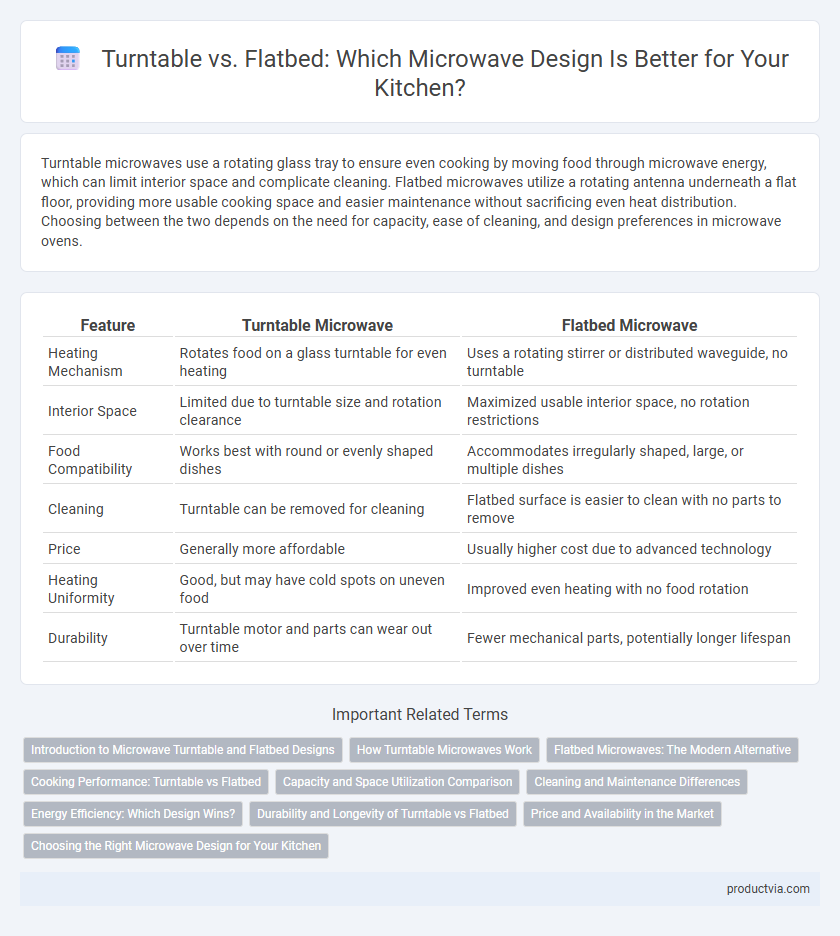Turntable microwaves use a rotating glass tray to ensure even cooking by moving food through microwave energy, which can limit interior space and complicate cleaning. Flatbed microwaves utilize a rotating antenna underneath a flat floor, providing more usable cooking space and easier maintenance without sacrificing even heat distribution. Choosing between the two depends on the need for capacity, ease of cleaning, and design preferences in microwave ovens.
Table of Comparison
| Feature | Turntable Microwave | Flatbed Microwave |
|---|---|---|
| Heating Mechanism | Rotates food on a glass turntable for even heating | Uses a rotating stirrer or distributed waveguide, no turntable |
| Interior Space | Limited due to turntable size and rotation clearance | Maximized usable interior space, no rotation restrictions |
| Food Compatibility | Works best with round or evenly shaped dishes | Accommodates irregularly shaped, large, or multiple dishes |
| Cleaning | Turntable can be removed for cleaning | Flatbed surface is easier to clean with no parts to remove |
| Price | Generally more affordable | Usually higher cost due to advanced technology |
| Heating Uniformity | Good, but may have cold spots on uneven food | Improved even heating with no food rotation |
| Durability | Turntable motor and parts can wear out over time | Fewer mechanical parts, potentially longer lifespan |
Introduction to Microwave Turntable and Flatbed Designs
Microwave ovens feature two primary designs for heating food evenly: turntable and flatbed. Turntable microwaves use a rotating glass tray to move food through microwaves, ensuring uniform cooking by exposing all parts to consistent heat. Flatbed microwaves employ a stationary, flat surface with an advanced wave distribution system, eliminating the need for a rotating tray and allowing more flexible interior space and easier cleaning.
How Turntable Microwaves Work
Turntable microwaves work by rotating food on a circular glass plate, ensuring even exposure to microwave energy and reducing hot spots during cooking. The rotating mechanism distributes microwaves more uniformly by constantly changing the position of the food relative to the microwave's magnetron. This design enhances heating efficiency and helps achieve consistent cooking results in compact kitchen appliances.
Flatbed Microwaves: The Modern Alternative
Flatbed microwaves utilize a rotating stirrer to distribute microwaves evenly, eliminating the need for a turntable and allowing for a larger, unobstructed cooking cavity. This advanced design enhances cooking efficiency and flexibility when heating irregularly shaped or multiple dishes simultaneously. The flatbed technology also simplifies cleaning and increases available space, making it a modern alternative favored in contemporary microwave designs.
Cooking Performance: Turntable vs Flatbed
Turntable microwaves offer even cooking by rotating food, reducing hot and cold spots, which is ideal for round or uniformly sized dishes. Flatbed microwaves use advanced wave distribution technology to cook food more evenly without rotation, providing greater clearance and accommodating larger, irregularly shaped containers. Flatbed design often enhances cooking performance in terms of space utilization and consistency for diverse food types, while turntables are more traditional but can limit container size and shape.
Capacity and Space Utilization Comparison
Turntable microwaves typically offer uneven cooking space due to rotating plates, limiting the size of dishes that fit inside, while flatbed microwaves maximize internal capacity with no rotating mechanism obstructing the cavity. Flatbed designs utilize space more efficiently by allowing uniformly distributed microwave energy, accommodating larger and oddly shaped cookware. This results in superior space utilization and increased overall capacity compared to traditional turntable models.
Cleaning and Maintenance Differences
Turntable microwaves require regular cleaning around the rotating plate and the cavity to prevent food buildup, which can be time-consuming due to the moving parts. Flatbed microwaves feature a smooth interior surface without a turntable, making wiping down and maintenance simpler and faster with fewer components to clean. The absence of a turntable mechanism also reduces maintenance issues related to motor or track wear, enhancing long-term usability.
Energy Efficiency: Which Design Wins?
Turntable microwaves often incur uneven energy distribution due to rotating plates causing inconsistent heating, leading to higher energy consumption. Flatbed microwave designs use advanced wave distribution technology to ensure uniform cooking without the need for a turntable, optimizing energy efficiency. Studies show flatbed models can reduce cooking times by up to 20%, translating to significant energy savings over traditional turntable microwaves.
Durability and Longevity of Turntable vs Flatbed
Turntable microwaves feature a rotating glass plate that evenly cooks food but can wear out over time due to motor and bearing fatigue, potentially reducing durability. Flatbed microwaves, using electromagnetic wave distribution, eliminate mechanical parts, offering enhanced longevity and fewer maintenance issues. The absence of moving components in flatbed designs typically leads to greater reliability and a longer lifespan compared to traditional turntable microwaves.
Price and Availability in the Market
Turntable microwaves generally offer lower prices and wider availability due to their simpler design and established production. Flatbed microwaves, while gaining popularity for even cooking and easier cleaning, tend to be more expensive and less common in the market. Consumers seeking budget-friendly options typically find turntable models more accessible across various retailers.
Choosing the Right Microwave Design for Your Kitchen
Turntable microwaves provide even cooking by rotating food through microwave energy, making them ideal for small to medium kitchen spaces with limited counter area. Flatbed microwaves use a rotating antenna beneath a flat surface, eliminating the need for a turntable and offering more usable interior space for larger or irregularly shaped dishes. Selecting the right microwave design depends on your cooking habits, kitchen space, and the size and shape of meals you frequently prepare.
Turntable vs Flatbed for microwave design Infographic

 productvia.com
productvia.com